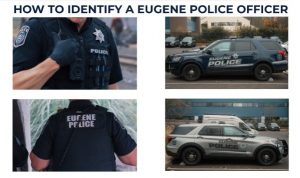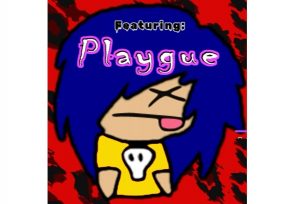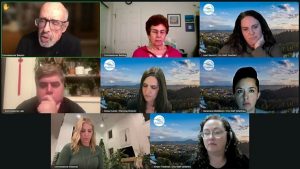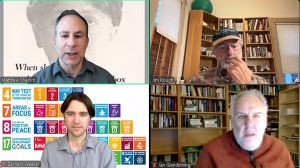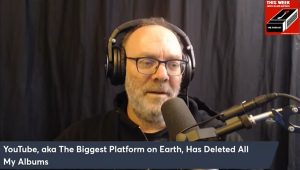Stories of Bridgeway House: Kristin Collier
12 min read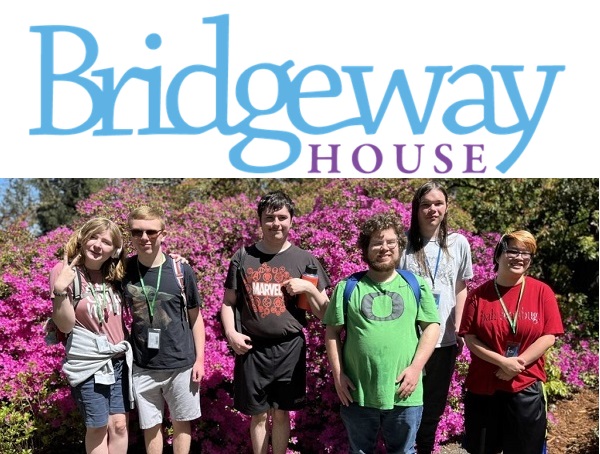
Presenter: To celebrate Autistic Pride Day June 18, we’re visiting with the extended family of students, teachers, parents, grandparents, staff, and volunteers at Bridgeway House. She’s been the social group coordinator and also ran the Sexuality, Health, And Personal Exploration program, also known as SHAPE. Kristin Collier:
Kristin Collier: The social group programs were a place that kids could come after school and gather together with other kids that were around their age and do different activities, according to the group’s interests and abilities.
[00:00:35] And there was always this little piece of social skill curriculum that was taught at the beginning, and one of their favorites was at the beginning of the session, we would all share what was ‘New and Better’ in our week.
[00:00:47] And when kids would first come to the program, they’d be like, ‘Oh no, there’s nothing new and better, everything’s really bad in my life.’ And then, we’d kind of help ’em look at, ‘What could possibly be just like a little bit better?’ or ‘What you know was okay,’ and then slowly when they came to class, they would start sharing something that they were excited to share, and then they would get more and more excited to share everything from, like, having a really nice time with their dad at the park the day before.
[00:01:19] And what happens—what we know from brain science—is that their brains begin to rewire. To, instead of looking for the negative in their environment, which is natural with the negativity bias in the brain, but they’re retraining it to look for the positive in their environment.
[00:01:34] And so that’s a piece of what we were teaching. Not just skills to be social with other people, but skills in navigating our own brain and emotions so as their brains began to rewire to look for the positive in their environment, what happens in their bodies? They get calmer. They get more confident, they’re breathing more easily, all of their body systems are working more easily.
[00:01:59] The adrenaline goes down, they can relax, and then what happens? They connect more easily with other people. They’re not in ‘fight, flight, or freeze’ mode anymore.
[00:02:07] And these kids were kids that would go to school and be in ‘fight, flight, or freeze’ mode. And instead, when they would come in right away from the beginning of the session, we would start with that and that would set the tone of the session, and they couldn’t wait to share what was new and better in their world.
[00:02:23] And then all week long they’d be thinking about it and looking for, ‘What am I going to share this time? And they were so excited.
[00:02:29] And then they had this, this thing to connect with their friends with as well. There was like this common ground, ‘Oh, you like to play that game on Xbox? I do too.’ You know?
[00:02:38] And so there was like this moment of learning about each other while we were feeling good together, while we were sharing this group celebration.
[00:02:46] And we could also infiltrate other skills, like looking for the deeper needs that were met in each of those celebrations and practicing naming those needs. And then the kids got to hear that over and over.
[00:02:58] And that was another key piece that they took away because one of the foundations of the social group program was compassionate communication, also known as nonviolent communication. And the idea behind that is every behavior is an attempt to meet a need.
[00:03:13] That’s really reassuring for kids who are really scared of their own behavior to realize, ‘Oh, there’s a reason I did that.’ You know, building compassion for themselves. Like, ‘oh, there’s a reason.’
[00:03:25] Also other people’s behavior. So while they used to get really irritated, because Johnny would always scream when, you know, somebody said something in particular, they’re like, ‘Oh yeah, that’s because, you know, he gets really nervous about, you know, X or Y,’ and they start to understand the world around them.
[00:03:41] They start to open up to curiosity about the world around them instead of being scared and pushing away and isolating themselves.
[00:03:50] And when I would hear from a parent: You know what, we were in the grocery store after social groups tonight and my son used to really freak out whenever a baby cried. And instead he grabbed my arm and he said, ‘Mom, that baby is crying for a reason. I wonder what it needs.’
[00:04:06] It changes not only that child’s life, but also the family’s life, the family dynamics, and for parents to see their kids able to connect with the world in that way, where before they seemed so scared and separate.
[00:04:25] It gives them hope. And when people have more hope, then they’re willing to try harder to connect. Then they’re willing to try harder to build those bridges and they’re more willing to take risks socially with their family to go out to dinner, to go to that party because the kids are starting to get skills.
[00:04:44] And I would talk with parents later, like 10, 15 years down the line—I’ve been in this field for over 20 years now—and I had a parent recently tell me, ‘Oh my gosh, I have four kids and three of them were not on the autism spectrum, and one was, and the one who was came through your social group program and he came out with more skills to navigate his career of choice than any of the other kids.’
[00:05:08] And I’m so thrilled because it’s, you know, it’s a really challenging career and see that my other kids who have that same career are having a much harder time with it because they haven’t learned those basic skills for calming themselves, for focusing on the positive.
[00:05:23] And it’s easier said than done. These things take practice, which is why it’s so important to have these social groups on a weekly basis so that they can get together and share this culture, where the focus is more on what we can do than what we can’t do. So focus on the positive on what’s going well, rather than what’s not going well.
[00:05:43] These are kids who have spent all day at school hearing things that haven’t gone well. You know, seeing ways that they’re not living up to a standard that was built for ‘everyone,’ across the board.
[00:05:54] And when they would come to social group, they would tell me, ‘Oh my gosh, this is the place where I feel like I’m really at home, or I feel like I can really be myself. Other than my family, this is the place where I’m comfortable.
[00:06:07] They’re the ones who did all the hard work, but a lot of times they didn’t know they were doing the hard work. And that’s the really fun part because it was infused with games and activities where they were focused on each other.
But because you set them up for success by having that opportunity to connect and feel good at the beginning, and then those skills, by the time they get to that free open time, it’s all easy and we’re just there to support. And that builds a bridge for them as they go into the world where they need less and less and less support.
[00:06:37] Every social group was like a mini real-life opportunity that, you know, that we faded ourselves out and they were handling it more and more on their own by the end of each group.
[00:06:48] Presenter: She was also involved with the SHAPE program at Bridgeway House. SHAPE stands for Sexuality, Health, And Personal Exploration. Kristin Collier:
[00:06:57] Kristin Collier: SHAPE was a combination of an hour to an hour and a half of lesson, with the ‘New and Better’ still.
[00:007:04] And this time, sharing information about sexuality and communication around sexuality, which is really, really important because the kids that we work with are often at risk of sexual assault. Because others take advantage of them. Because they don’t process language well, and they’re often very shy and don’t use a lot of words.
[00:07:27] And then the other place that can be problematic is they might themselves be at risk of perpetrating quite inadvertently sexual assault, for example, usually because either they don’t understand something or because of their own sensory needs.
[00:07:42] And it can be even something like, I had a student who would pull his swim trunks down underwater at the pool because the waistband was so uncomfortable for him.
[00:07:53] And so he knew to do it underwater so that people didn’t see him. He knew not to do it on the thing. And you know, when you’re five years old and you do that, it’s not a big deal. when you’re 13 years old, it’s a big deal.
[00:08:04] So not realizing what it means to bare certain parts of the body or to say certain words or to be in somebody’s space, these are areas that kids needed to learn about their bodies, about sexuality, about consent, and what that means both to participate in it in either way, in being the person who’s asking or the person who’s agreeing to something, they had to understand what they’re agreeing to.
[00:08:30] And it was hard to know that without giving some really specific words around sexuality too, which was always, you know, so much a giggle at first. And often I’d have kids who were wearing hoodies, you know, who had their hoodie tied down so that there was just a peep pole that they were at the back of the class, and then slowly they’d move forward because one of the things that we were very matter of fact about how we were sharing things.
[00:08:53] The curriculum that I used was very interactive and I had adapted it very heavily with activities so that they were constantly moving and engaging with the work and showing their understanding and not just speaking their understanding. And they became curious and more interested. And I love that we had these discussions happening amongst people of all genders.
[00:09:14] Because a lot of times, I don’t know, when I was growing up, there was like, oh, you know, female-gendered over here, male-gendered over there. And now we have like this all-gender group, which includes, you know, male, female, non-binary, all of it. And it’s important to have those discussions with all of those folks because if you do choose a partner of the opposite sex, you need to know how to talk to them, right?
[00:09:36] And you also need to know when you need help from your parents, no matter which gender they are, and how to ask for that and how to be clear when you’re asking for that about what it is that’s a problem. So having the language around that was really important, and having the language around how to describe what happened to you was also important. Sometimes sadly so.
[00:09:57] And we began the program with the intent and I believe that it was effective in supporting kids in staying out of tricky situations and giving them the skills and the confidence to go into their adult life and to be able to navigate their sexuality in relationship in ways that were effective and joyful.
[00:10:19] The other half of the SHAPE program was an hour of either martial arts or dance, some kind of movement program so that the kids got up and were moving and interacting with each other that way and getting familiar with their bodies.
[00:10:35] Because a lot of our kids get overwhelmed by the sensations in their bodies and to get used to the feeling of their own breath and to be able to notice it, to get used to the feeling of their discomfort inside about anxiety or whatever it is, and learn how to just sit with it. And learn how to use movement as a way of dispelling some of that just to move it through was really important.
[00:11:04] And the other thing that we did that was so fun during the SHAPE program was to invite the parents a couple of times a year and have the kids teach the parents what they were learning.
[00:11:16] And the kids loved it if the parents didn’t know all of the ins and outs and of all of the terms, and let me tell you, it wasn’t just now and then. A lot of times the parents were surprised at what they didn’t know that their kids did know. And it gave the kids a chance to be the teachers, which they were really excited to study for.
[00:11:34] And to show their parents how they showed up as a leader in that setting. How they could stand up in front of the class and speak not only to their parents, but to all of the parents, and that they had that quality of confidence. So this is a skill, these are skills, and these are ways of being emotionally that really trickle outwards into the community over a long period of time.
[00:12:03] There’s the period of the child’s development. I would often get students from age third grade in social groups and about sixth grade for SHAPE. And these are most formative years, right? When you think back to your childhood and your teachers, you remember that stuff. That’s, like, foundational for the rest of your life: How you learn to think about yourself and others. This is foundational.
[00:12:26] So that is crucial in terms of shaping their lives and then the adult that they grow into being. That is, how many, 40, 50, 60 years’ worth of being a community member. That’s so important.
[00:12:42] And having programs like Bridgeway House is valuable to the community on so many levels. It’s valuable in serving these kids. But it’s so much more than that. Now, more than ever, we need all of us the opportunity to learn compassion.
[00:13:03] We need the chance to learn how to be more aware of others’ needs because we want others to be aware of our needs. So it’s very important that we all tune into one another’s needs. Maybe tuning into needs just by listening to this program and going, oh my gosh, you know, ‘I can see how the kids would need this or that,’ and then to act on, to do something about meeting those needs is a way to experience empowerment.
[00:13:33] And that’s one of the things that I would teach my kids too. There was like this opportunity to step into and make a difference, make an impact on your world, and that’s empowerment.
[00:13:42] So you have an opportunity as a listener too, to do something. And throughout life we have these opportunities to support groups like Bridgeway House that actually build community. They give us a chance to help. They give us a chance to learn how to listen. They give us a chance to learn compassion. And whenever you help any aspect of community that helps you. Not just in those ways, but also because when we see those kids excelling, we are excelling and it just moves outwards in such a valuable way that affects not only this moment but the rest of our lives.
[00:14:23] It’s such an honor to watch these kids learn to navigate themselves, the world, their relationships and to be successful.
[00:14:36] And I think that the people that have surrounded them, this is a culture really, that we make in Bridgeway House, that is a culture of believing in one another. It’s a culture of compassion and it’s a culture of care and it, it ripples out through the students. It includes the families. It ripples into the friends of the families.
[00:15:01] It ripples into community. It ripples into people who are listening that just makes the world a better place. it’s a world that we all feel more proud of living in, right?
[00:15:13] Presenter: We’ve been speaking with Kristin Collier, who has been with the social program and the SHAPE program at Bridgeway House, a treasure right here in Eugene Springfield. It started as a group of parents meeting in a living room and providing mutual aid. Now two sites serve 90 students from 17 school districts. With more wanting to attend, KEPW is celebrating the many success stories. You can donate through the website, BridgewayHouse.org, or call (541) 345-0805.
During summer break, calls to Bridgeway House will be automatically transferred to school admin team cell phones. For faster service, call the cell phones directly: (541) 743-5159 and (505) 930-6910.
